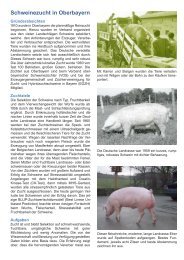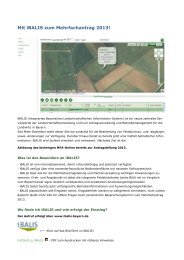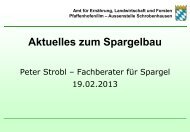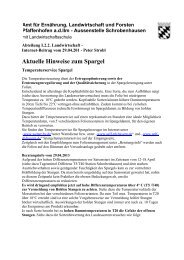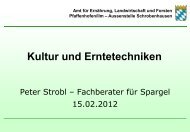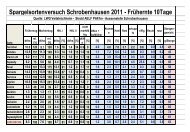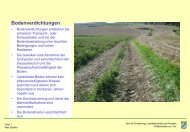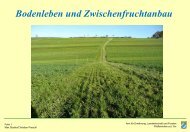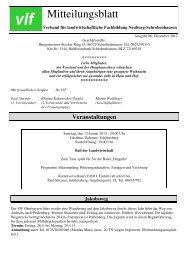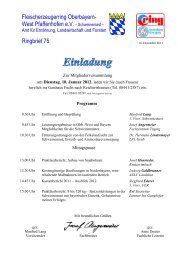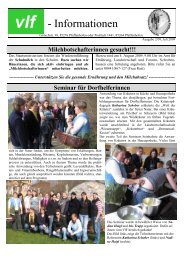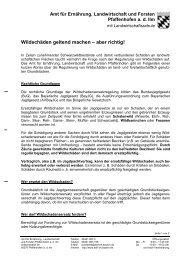Anlage von Zwischenfruchtversuchen 2011 AELF Pfaffenhofen ...
Anlage von Zwischenfruchtversuchen 2011 AELF Pfaffenhofen ...
Anlage von Zwischenfruchtversuchen 2011 AELF Pfaffenhofen ...
Sie wollen auch ein ePaper? Erhöhen Sie die Reichweite Ihrer Titel.
YUMPU macht aus Druck-PDFs automatisch weboptimierte ePaper, die Google liebt.
<strong>Anlage</strong> <strong>von</strong> <strong>Zwischenfruchtversuchen</strong> <strong>2011</strong> <strong>AELF</strong> <strong>Pfaffenhofen</strong><br />
Demoversuch <strong>von</strong> Zwischenfrüchten für Maismulchsaat <strong>2011</strong> - 2012<br />
Betrieb: Schapfl Erwin, Ammerfeld - Rennertshofen<br />
Vorfrucht: Winterweizen, Stroh abgefahren<br />
Düngung: 25 m³ Rindergülle<br />
Bodenbearbeitung: gepflügt am 23.08.<strong>2011</strong><br />
Aussaat mit Kreiselegge und Sämaschine<br />
Zwischenfruchtansaat am 25.08.<strong>2011</strong><br />
Nr.<br />
Parzellenbreite<br />
(m)<br />
1 12 Landsberger Gemenge<br />
Fruchtart Sorte Firma / Amt<br />
Deutsche<br />
Saatveredelung<br />
DSV<br />
Saatstärke<br />
(kg/ha)<br />
50 120<br />
2 12 Sommerwicke + Hafer <strong>AELF</strong> <strong>Pfaffenhofen</strong> 30 + 30 = 60 33,5<br />
3 12<br />
Alexandrinerklee-<br />
Phaceliamischung<br />
Dehner 18 58<br />
4 12 MS 100 A Bay. Futtersaatbau 34 70<br />
5 12<br />
MS 100 A +<br />
Hafer<br />
6 12 Terra-Life - Rigol<br />
7 12 Terra Life - Bio Max<br />
8 12 Terra Life - N-fix<br />
9 12<br />
Alexandrinerklee +<br />
Gartenkresse<br />
<strong>AELF</strong> <strong>Pfaffenhofen</strong><br />
Deutsche<br />
Saatveredelung<br />
DSV<br />
Deutsche<br />
Saatveredelung<br />
DSV<br />
Deutsche<br />
Saatveredelung<br />
DSV<br />
<strong>AELF</strong> <strong>Pfaffenhofen</strong><br />
25 + 20 =<br />
45<br />
Preis €/ha Bemerkungen<br />
55<br />
47 82,5<br />
24 38<br />
43 65<br />
10 + 6 =<br />
16<br />
ca. 51,20<br />
10 12 MS 100 S Bay. Futtersaatbau 20 40<br />
11 13 Planterra ZWH 4022 Baywa 25 ca. 62,4<br />
12 12 Planterra ZWH 4021 Baywa 26 ca.64<br />
13 12<br />
Hafer + Senf +<br />
Gartenkresse +<br />
Phacelia +<br />
Ackerbohnen + Wicken<br />
<strong>AELF</strong> <strong>Pfaffenhofen</strong><br />
10 + 1,5 + 1 +<br />
3 + 4,5 + 5 =<br />
25<br />
30% Inkarnatklee, 50% Welsches<br />
Weidelgras, 20% Winterwicke<br />
Wicke = N - Sammler<br />
14 9 Phacelia Lila Bay. Futtersaatbau 7 26,6 Gesundungsfrucht<br />
15 6 Senf Albatros Saaten Union 15 25,5<br />
Diese Preise sind Vergleichspreise/Orientierungspreise ohne Mwst (Stand Oktober <strong>2011</strong>)<br />
Christian Preschl, Wasserberater, Fachzentrum Agrarökologie, <strong>AELF</strong> <strong>Pfaffenhofen</strong>-Schrobenhausen<br />
28,5<br />
74 % Alexandrinerklee, 26 % Phacelia<br />
18% Alexandrinerklee, 10% Seradela,<br />
62% Wicken, 3% Phacelia, 3%<br />
Gartenkresse, 4% Ramtillkraut<br />
MS 100 A + Hafer zum<br />
Ausprobieren<br />
65% Bitterlupine blau, 5%<br />
Sonnenblume, 4% Alexandrinerklee,<br />
5% Serradella, 1% Phacelia, 6%<br />
Schwarzhafer, 6% Öllein, 8%<br />
Buchweizen<br />
3% Ölrettich, 16% Buchweizen, 66%<br />
Hafer, 4% Phacelia, 7% weißer Senf,<br />
4% Alex, nicht in Rapsfruchtfolgen<br />
50% Erbsen, 5% Alex, 2% Perserklee,<br />
5% Serradella, 1% Phacelia, 2%<br />
Ramtillkraut, 8% Buchweizen, 1%<br />
Sonnenblumen, 26% So-Wicke, für<br />
Rapsfruchtfolgen<br />
Kresse als alternative zu Senf,<br />
Alexandrinerklee = Stickstoffsammler<br />
75% Alexandrinerklee, 15%<br />
Gartenkresse, 10%<br />
Ramtillkraut für<br />
Rapsfruchtfolgen<br />
40% Sommerwicke, 15%<br />
Alexandrinnerklee, 15% Perserklee,<br />
20% Phacelia, 10% Ramtillkraut<br />
23% Ölrettich, 8% Gartenkresse, 39%<br />
Sommerwicke, 30% Alexandrinerklee<br />
nicht in Rapsfruchtfolgen wegen<br />
Kohlhernie
Standort Ammerfeld<br />
Alexandrinerklee-Phaceliamischung
Versuch Nematodenresistente Zwischenfrüchte für<br />
Zuckerrübenmulchsaat <strong>2011</strong> - 2012<br />
Betrieb: Amberger Engelbert, Oberhartheim - Vohburg<br />
Vorfrucht: Winterweizen, Stroh gehäckselt<br />
Bodenbearbeitung: 1x Grubbern Anfang August zum Auflaufen des Ausfall WW<br />
1x Grubbern kurz vor der Saat<br />
Düngung am 02.08.<strong>2011</strong>: 5,4 dt Phosphatkali (12P/24K) und 2,85 dt 40er Kornkali<br />
Zwischenfruchtansaat am: 18.08.<strong>2011</strong>, Saat erfolgte mit Kreiselegge und Pneumatischer Sämaschine<br />
Nr.<br />
Parzellenbreite<br />
(m)<br />
1 18<br />
2 18<br />
3 18<br />
4 18<br />
5 18<br />
6 18<br />
Fruchtart Sorte Firma / Amt<br />
Ölrettich<br />
Sorte Contra<br />
Ölrettich<br />
Sorte Defender<br />
Ölrettich<br />
Sorte Colonel<br />
Ölrettich<br />
Sorte Corporal<br />
Senf<br />
Sorte Maxi<br />
Senf<br />
Sorte Accent<br />
7 18 Terra-Life - Beta-Max<br />
8 6<br />
9 18<br />
10 15<br />
Senf (Maxi) +<br />
Alexandrinerklee (Axi)<br />
Ölrettich (Compass) +<br />
Alexandrinerklee (Axi)<br />
Terra-Life - Beta-Max +<br />
Ölrettich (Compass)<br />
Saatstärke<br />
(kg/ha)<br />
Preis €/ha Bemerkungen<br />
Saaten Union 25 85 Nematodenresistent<br />
Saaten Union 25 105 Nematodenresistent<br />
Saaten Union 25 85 Nematodenresistent<br />
Saaten Union 25 85 Nematodenresistent<br />
Saaten Union 15 30 Nematodenresistent<br />
Saaten Union 15 36 Nematodenresistent<br />
Deutsche<br />
Saatveredelung<br />
DSV<br />
42 77<br />
<strong>AELF</strong> <strong>Pfaffenhofen</strong> 10 + 10 = 20 46<br />
<strong>AELF</strong> <strong>Pfaffenhofen</strong> 15 + 10 = 25 73<br />
Dies Preise sind Vergleichspreise/Orientierungspreise und ohne Mwst (Stand Oktober <strong>2011</strong>)<br />
Christian Preschl, Wasserberater, Fachzentrum Agrarökologie, <strong>AELF</strong> <strong>Pfaffenhofen</strong>-Schrobenhausen<br />
25%Sommerwicken, 18% Bitterlupinen<br />
blau, 23% Felderbsen, 5% weißer Senf<br />
(nem.res.), 10% Alexandrinerklee, 3%<br />
Tilly, 12% Rauhafer, 4% Phacelia<br />
Nematodenresistenter Senf,<br />
Alexandrinerklee N-Sammler<br />
Nematodenresistenter Ölrettich,<br />
Alexandrinerklee N-Sammler<br />
<strong>AELF</strong> <strong>Pfaffenhofen</strong> 21 + 10 = 31 72,5 zum Ausprobieren
Standort Oberhartheim
Demoversuch Zwischenfrüchte für Kartoffelmulchsaat <strong>2011</strong> - 2012<br />
Betrieb: Thomas Felbermeir, Kahlhof - Neuburg/Donau<br />
Vorfrucht: Winterweizen / Körnererbsen, Stroh gehäckselt<br />
Düngung im Herbst: keine<br />
Bodenbearbeitung: 08.08.<strong>2011</strong> Frost Flügelschargrubber (Vertrieb: Schmotzer)<br />
13.08.<strong>2011</strong> Großfederzinkenegge mit Flachstabwalze und Nachstriegel<br />
Saat : Frost Flügelschargrubber + Lely Kreiselegge + Hatzenbichler Säkasten<br />
Aussaat der Zwischenfrüchte am 18.08.<strong>2011</strong><br />
Nr.<br />
Parzellenbreite<br />
(m)<br />
1 12 Terra-Life - Sola Rigol<br />
Fruchtart Sorte Firma / Amt<br />
Deutsche<br />
Saatveredelung<br />
DSV<br />
Saatstärke<br />
(kg/ha)<br />
55 104<br />
Preis €/ha Bemerkungen<br />
2 12 Alexandrinerklee Axi 23 ca. 60 Stickstoffsammler<br />
3 12<br />
4 12<br />
Alexandrinerklee +<br />
Gartenkresse<br />
Alexandrinerklee-<br />
Phaceliamischung<br />
<strong>AELF</strong><br />
<strong>Pfaffenhofen</strong><br />
10 + 6 =<br />
16<br />
ca. 51,20<br />
Dehner 18 58<br />
5 12 TG-1 Terra Gold Humus Freudenberger 30 69<br />
6 12 Sandhafer Pratex Saaten - Union 50 120 zum Ausprobieren<br />
4% Alexandrinerklee, 48% Bitterlupine<br />
blau, 5% Öllein, 7% Ramtillkraut, 4%<br />
Serradella, 18% Sommerwicke, 4%<br />
Sonnenblumen, 8% Schwarzhafer, 2%<br />
Leindotter<br />
Kresse als Alternative zu Senf,<br />
Alexandrinerklee = Stickstoffsammler<br />
74% Alexandrinerklee = N -Sammler,<br />
26% Phacelia = Gesundungsfrucht<br />
15% Futtererbse, 15%<br />
Alexandrinerklee, 15% Serradella, 15%<br />
Phacelia, 20% Buchweizen, 20%<br />
Sommerwicken<br />
7 12 Phacelia Stala Bay. Futtersaatbau 6 22,8 Gesundungsfrucht<br />
8 12 Senf Maxi Saaten - Union 15 30<br />
9 12<br />
Sommerwicke +<br />
Hafer<br />
<strong>AELF</strong> <strong>Pfaffenhofen</strong><br />
30 + 30 = 60<br />
kg/ha<br />
10 12 TG-3 Terra Gold Solara Freudenberger 35 kg 78<br />
11 12<br />
12 12<br />
Alexandrinerklee +<br />
Ackerbohnen<br />
Planterra ZWH 4020<br />
Vitalis Pro<br />
33,5<br />
nicht in Rapsfruchtfolgen wegen<br />
Kohlhernie<br />
Sommerwicke als gegenspieler <strong>von</strong><br />
Rizotonia<br />
40% blaue Bitterlupine, 20%<br />
Buchweizen, 20% Ölrettich, 10%<br />
Futtererbse, 5% Phacelia MS, 5%<br />
Alexandrinerklee<br />
<strong>AELF</strong> <strong>Pfaffenhofen</strong> 20 + 5 = 25 56 zum Ausprobieren<br />
Baywa 25 ca.51,2<br />
13 12 SB 100 Bay. Futtersaatbau 20 55<br />
Diese Preise sind Vergleichspreise/Orientirungspreise ohne Mwst (Stand Oktober <strong>2011</strong>)<br />
Christian Preschl, Wasserberater, Fachzentrum Agraökologie, <strong>AELF</strong> <strong>Pfaffenhofen</strong>-Schrobenhausen<br />
64 % Saatwicke, 20 %<br />
Alexandrinerklee, 8 % Phacelia, 8 %<br />
Sonnenblumen<br />
25 % Alexandrinerklee, 25 %<br />
Persischer Klee, 40 % Saatwicke,<br />
10 % Phacelia
Standort Kahlhof<br />
Hafer + Sommerwicken<br />
Gartenkresse +<br />
Alexandrinerklee
Demo-Versuch Zwischenfrüchte für Zuckerrübenmulchsaat <strong>2011</strong> - 2012<br />
Betrieb: Gensberger Josef, Bergen - Neuburg/Donau<br />
Vorfrucht: Wintergerste, Stroh abgefahren<br />
Düngung: 15 m³ Rindergülle<br />
Bodenbearbeitung: 1 x Grubbern Ende Juli zum Auflaufen der Ausfall WG<br />
1 x Grubbern zur Einarbeitung der Gülle am 20 .08.11<br />
Saat erfolgte mit Kreiselegge und Sämaschine<br />
Zwischenfruchtansaat am 22.08.<strong>2011</strong><br />
Nr.<br />
Parzellenbreite<br />
(m)<br />
1 6 Terra-Life - Beta Max<br />
2 6<br />
Fruchtart Sorte Firma / Amt<br />
Alexandrinerklee-<br />
Phaceliamischung<br />
Deutsche<br />
Saatveredelung<br />
DSV<br />
Saatstärke<br />
(kg/ha)<br />
42 77<br />
Dehner 18 58<br />
3 6 MS 100 A Bay. Futtersaatbau 34 70<br />
4 6 MS 100 A + Hafer <strong>AELF</strong> <strong>Pfaffenhofen</strong><br />
5 6<br />
6 6<br />
Alexandrinerklee +<br />
Gartenkresse<br />
Hafer, Senf,<br />
Gartenkresse,<br />
Phacelia, Ackerbohnen,<br />
Wicken<br />
<strong>AELF</strong><br />
<strong>Pfaffenhofen</strong>,<br />
<strong>AELF</strong> <strong>Pfaffenhofen</strong><br />
25 + 20 =<br />
45<br />
10 + 6 =<br />
16<br />
10 + 1,5 + 1 +<br />
3 +4,5 + 5 =<br />
25<br />
Preis €/ha Bemerkungen<br />
55<br />
ca. 51,20<br />
7 6 Phacelia Stala Bay. Futtersaatbau 6 22,8<br />
8 6 Sommerwicke + Hafer <strong>AELF</strong> <strong>Pfaffenhofen</strong> 30 + 30 = 60 33,5<br />
9 6<br />
TG 2 Terra Gold<br />
Rübenfit<br />
28,5<br />
Freudenberger 27 64<br />
10 6 ZFB G 10 Dehner 35 75<br />
11 6 SB 100 Bay. Futtersaatbau 20 55<br />
Diese Preise sind Vergleichspreise/Orientierungspreise ohne Mwst (Stand Oktober <strong>2011</strong>)<br />
Christian Preschl, Wasserberater, Fachzentrum Agrarökologie, <strong>AELF</strong> <strong>Pfaffenhofen</strong>-Schrobenhausen<br />
25% Sommerwicken, 18% Bitterlupine<br />
blau, 23% Felderbse, 5% weißer Senf<br />
(nem. Res.), 10% Alexandrinerklee,<br />
3% Ramtillkraut, 12% Schwarzhafer,<br />
4% Phacelia<br />
74% Alexandrinerklee, 26% Phacelia<br />
18% Alexandrinerklee, 10% Seradella,<br />
62% Wicken, 3% Phacelia, 3%<br />
Gartenkresse, 4%<br />
Ramtillkraut<br />
MS 100A + Hafer zum<br />
Ausprobieren<br />
Kresse als Alternative zu Senf,<br />
Alexandrinerklee = Stickstoffsammler<br />
Gesundungsfrucht<br />
Wicke = N-Sammler<br />
50% Blaue Bitterlupine, 20% Ölrettich,<br />
10% Phacelia, 10% Gelbsenf, 10%<br />
Alexandrinerklee<br />
20 % Felderbse, 40 % wicken, 8 %<br />
Serradella, 5 % Phacelia, 22 %<br />
Alexandrinerklee, 5 % Gartenkresse<br />
25 % Alexandrinerklee, 25 %<br />
Persischer Klee, 40 % Saatwicke 10<br />
% Phacelia
Standort Bergen



